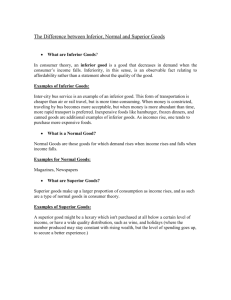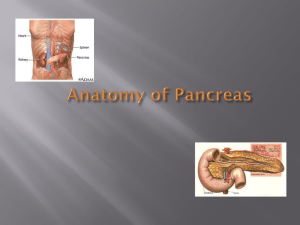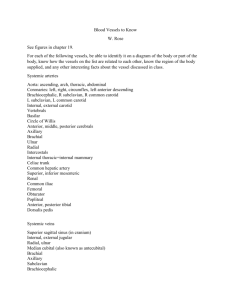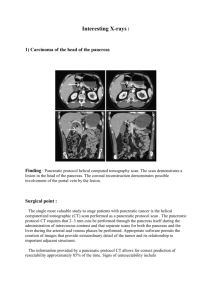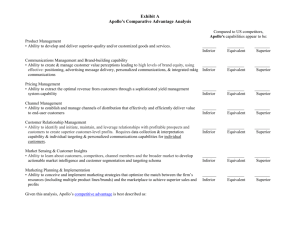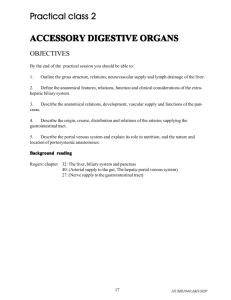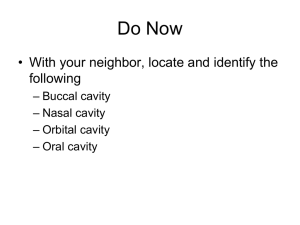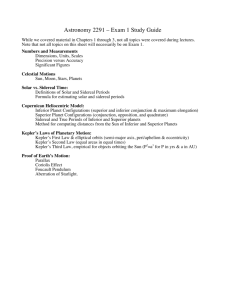Gastro40-HALabPracticalReview
advertisement
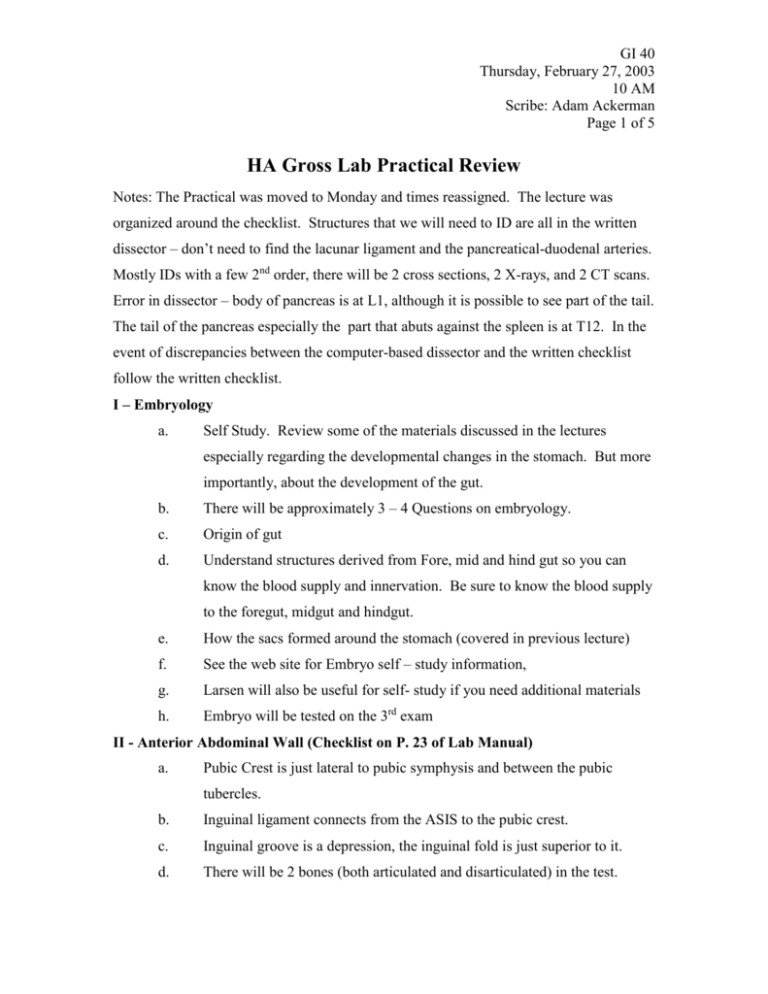
GI 40 Thursday, February 27, 2003 10 AM Scribe: Adam Ackerman Page 1 of 5 HA Gross Lab Practical Review Notes: The Practical was moved to Monday and times reassigned. The lecture was organized around the checklist. Structures that we will need to ID are all in the written dissector – don’t need to find the lacunar ligament and the pancreatical-duodenal arteries. Mostly IDs with a few 2nd order, there will be 2 cross sections, 2 X-rays, and 2 CT scans. Error in dissector – body of pancreas is at L1, although it is possible to see part of the tail. The tail of the pancreas especially the part that abuts against the spleen is at T12. In the event of discrepancies between the computer-based dissector and the written checklist follow the written checklist. I – Embryology a. Self Study. Review some of the materials discussed in the lectures especially regarding the developmental changes in the stomach. But more importantly, about the development of the gut. b. There will be approximately 3 – 4 Questions on embryology. c. Origin of gut d. Understand structures derived from Fore, mid and hind gut so you can know the blood supply and innervation. Be sure to know the blood supply to the foregut, midgut and hindgut. e. How the sacs formed around the stomach (covered in previous lecture) f. See the web site for Embryo self – study information, g. Larsen will also be useful for self- study if you need additional materials h. Embryo will be tested on the 3rd exam II - Anterior Abdominal Wall (Checklist on P. 23 of Lab Manual) a. Pubic Crest is just lateral to pubic symphysis and between the pubic tubercles. b. Inguinal ligament connects from the ASIS to the pubic crest. c. Inguinal groove is a depression, the inguinal fold is just superior to it. d. There will be 2 bones (both articulated and disarticulated) in the test. e. GI 40 Thursday, February 27, 2003 10 AM Scribe: Adam Ackerman Page 2 of 5 2 layers of superficial fascia, Camper’s and Scarpa’s f. Remember the direction of muscle fibers g. *Know what structures are found behind rectus abdominus muscle h. Arcurate line, easier to see when rectus abdominus cut away, if tagged it will be prominent i. Below (or inferior to) arcurate line, a pinned structure would be the transversalis fascia j. Lacunar ligament attaches to the pectineal line-important for repair of inguinal hernias k. For blood supply: focus on superior and inferior epigastric arteries l. Cremaster Muscle – not in females, forms covering of spermatic cord, may be present as small muscle fiber on the spermatic cord; derived from internal abdominal oblique. Others anterior abdominal wall muscles contribute fascia and not muscle fibers, so any muscle fiber around spermatic cord will be the cremaster muscle. m. Look for superficial inguinal ring where ilioinguinal nerve exits n. If conjoint tendon (falx inguinalis) is tagged it will be in the region near the superficial inguinal ring area. III. - Peritoneal Cavity and Abdominal Viscera (Checklist p. 27) a. Know structures on the posterior aspect of the anterior abdominal wall and what they represent embryologicaly. b. Median umbilical ligament urachus c. Median umbilical ligaments umbilical arteries d. Lateral umbilical ligaments inferior epigastric arteries and veins (still patent) e. Linea semilunaris is lateral border of rectus abdominus muscle f. Know parietal peritoneum (innermost lining) g. Don’t need to ID phrenicocolic (goes to splenic flexture of colon) h. Transversalis fascia more easily seen from the front behind rectus abdomini and below arcuate line. i. GI 40 Thursday, February 27, 2003 10 AM Scribe: Adam Ackerman Page 3 of 5 Know parts of the stomach and what ligaments attach to each area j. Lesser curvature: hepatogastric and hepatoduodenal k. Greater curvature: greater omentum (gastrocolic, gastrosplencic, gastrophrenic ligaments) l. Small intestines, be able to differentiate jejenum from ileum. ID the vasa rectae, “windows” m. Open up stomach and ID rugae, pyloric sphincter n. In duodenum be able to ID major duodenal papilla, plicae circularis, o. Can skip ligament of Treitz (important surgically to differentiate upper from lower GI in the clinics) p. Colon will be left in the body; small intestine will probably be tested outside of the body q. Don’t try to visually ID Peyer’s patches, observed better under the microscope. r. Be able to ID parts of large intestines like the teniae coli, appendices epiploicae or fatty tags, and haustrae coli IV. – Accessory Organs of Gastrointestinal Tract (Checklist p. 30) a. *Know classical and functional lobes of the liver b. Functional right lobe is classical right lobe and caudate process of caudate lobe c. ID liver ligaments especially Triangular and Coronary ligaments d. H-shaped structures: on visceral surface – right = gallbladder and inferior vena cava, left = Falciform ligament with round ligament of liver (embryologicaly the umbilical vein), and ligamentum venosum (fetal structure ductus venosus – connects portal vein to inferior vena cava shunts around non-functional liver) e. Cystic duct in liver, and other extrahepatic bile ducts and how formed (right and left hepatic ducts join together to form the common hepatic duct) GI 40 Thursday, February 27, 2003 10 AM Scribe: Adam Ackerman Page 4 of 5 f. ID ducts in liver, outside or in the cadaver g. Parts of pancreas and gall bladder h. Spleen – know splenic artery but forget about splenic ligaments The tape cut out at this point so the rest is from my notes, I don’t think that this is the first time the tape has failed on scribes, I suggest bringing your own recorder if you have one. V. – Blood Vessels of Gastrointestinal Tract (Checklist p. 32 – 33) a. Don’t have to know lymphatics b. ID structures and where their blood supply comes from c. Short gastrics in fundus may not be tagged, because they too small d. Know blood vessels in relation to the organ such as the stomach, the rest are large and can be ID’d fairly easily. e. Know the Superior Mesenteric branches. Do not ID the inferior pancreaticoduodenal arteries f. There are many natural variations, vessels tend to be named where they go to (right and left Colic arteries go to the ascending and descending colon respectively.) rather than how they come off from the main branches. BE SURE TO FOLLOW THE BLOOD VESSELS AND SEE WHERE THEY ARE GOING. g. For the veins, ID the portal vein, superior mesenteric, inferior mesenteric and splenic vein. VI. - Cross Sections & Radiology(Will be Tested on the Computers in Lab) a. Spleen (part of it) and body of pancreas are mostly visible at L1, also superior mesenteric artery is observed to arise from the anterior portion of the aorta and is visible posterior to pancreas. THIS IS QUITE CHARACTERISTIC IN CROSS SECTIONS OR CT AT THIS LEVEL b. Netter shows cross sections from the top or superior view, lab X-sections and CT scans are shown from the inferior view (similar to how you view a GI 40 Thursday, February 27, 2003 10 AM Scribe: Adam Ackerman Page 5 of 5 patient when doing an internal examination in female patients, or when delivering a baby in the labor room) c. Portal vein may also be visible posterior (or dorsal) to the pancreas d. L2 part of the head of the pancreas is visible, renal arteries going to kidneys are visible, part of spleen is still visible, most of liver cannot be seen, jejenum and right colic flexure are both visible. Can also see the left renal vein which drains into the inferior vena cava as it crosses anterior to the aorta. Can see the superior mesenteric artery anterior (or ventral) to the body of the pancreas. The superior mesenteric vein is to the right of the artery. In this view, can see that that superior mesenteric vessels are immediately anterior (or ventral) to the uncinate process of the pancreas, and left renal vein. e. Radiology – Upper GI is above ligament of Treitz, be able to ID parts on a radiograph. Jejejunum has a feathery appearance f. Radiology – Lower GI, ID the ileum, right, transverse, and left colic, sigmoid colon, rectum, etc. g. CT scans – look like X-sections and are observed from the inferior view. h. Aorta won’t have visible lumen in CT, see leaflets of the diaphragm (appear as wings) on either side of aorta as it passes through the diaphragm. i. Superior mesenteric artery behind or dorsal to head of the pancreas at level of L1, then becomes anterior or in front of the uncinate process of the pancreas at L2. j. CT at L2 – Spleen is smaller, inferior vena cava drains the renal vein that cross anteriorly to the aorta. k. Superior Mesenteric artery also crosses anterior to the 3rd part of duodenum and the left renal vein.
